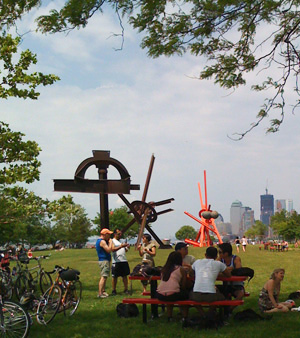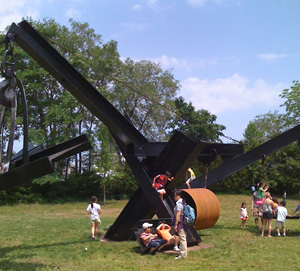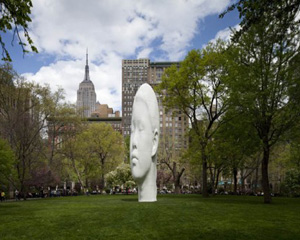Lazing in Summer
John Haberin New York City
Summer Sculpture 2011
Mark di Suvero, VISTA, and Jaume Plensa
I love the thought of summer sculpture. It gets me crossing New York City on long afternoons in sunlight, to remember its breadth, its parks, and its waterfronts. It is a very special hybrid, too, like a monument to laziness and transience. Could summer 2011 have grown lazier?
Massive and stable
Outdoor sculpture is massive and stable. It looks back to public memorials and to indoor sculpture before appropriation scattered it from wall to wall. Summer art is temporary, only while the neighbors are away for the weekend. It is also the result of chaos and compromise among competing arts groups. Governors Island alone hosts at least four groups from two boroughs, and they seem unaware of one another. It is New York creative ferment and cultural politics in miniature. 
This one summer, though, pretty much everyone has agreed to play it safe. Maybe it comes with success, or maybe it comes with the recession. Renovation of Brooklyn Bridge Park has displaced one Brooklyn arts coalition until 2012. Governors Island has turned from group shows and emerging artists to Mark di Suvero, curated by a Hudson Valley museum. Just try to say "Storm King at Governors Island" without a hush falling. di Suvero, now in his late seventies, also still has a stake in Socrates Sculpture Park, along with a group show devoted to its vistas. Madison Square Park has a single statue, by Jaume Plensa, on the scale of prehistory and with a back story to match.
The Met has settled down as well, with an older artist still. The five works on its roof amount to a judicious survey of Anthony Caro, starting with his first polychrome sculpture, from 1961. Its yellow plane tilts slightly up, like the blade of a plow. Three smaller sheets on top at different angles might be tumbling gently down. A more recent work reminds me of airplane hangers or maybe the Kimbell Art Museum in Forth Worth. Others run through Caro's clusters of heavy, unpainted steel.
From the start, the Brit was translating the welding of David Smith, the polychromes of Alexander Calder, and Pop Art color into slow motion. These abstractions are meant not to shock but to stay put. City Hall Park, too, settles on a career survey and a single old master, Sol LeWitt, who died in 2006. LeWitt was always at his most stable and minimal in sculpture, with a lifelong homage to the square. Works build on a single white cube reduced to its frame. Others nest open cubes and rectangular solids, like the Empire State Building.
One work even translates the formula into a slimmer, taller tower in concrete like cinder blocks. The occasional free-form piece looks weak or out of place. Still, it gains from context, as a kind of variation on a cube. When one comes to the incomplete cubes, the framing elements become less a founding vocabulary than a falling apart. That is exactly what makes his wall drawings more optically active as well. Things finally make sense as they finally refuse to cohere.
Enjoy, and get strolling. You have a lot of ground to cover, and the weekend crowds will be back before you know it. That first week in September is bittersweet. Gallery openings will remind you of New York's cultural activity, but also of why you would rather be outside. If it seems safe now, the art world is like that, and both di Suvero and LeWitt have had access to Madison Square in past years. It scares me already.
Pop-up playground
How often I wished that I could hop on the subway to Storm King. The art center goes beyond sculpture garden, to a vast and changing outdoor museum. I have managed only two trips twenty-five years apart, and each brought a fresh history of Calder, Smith, Ursula von Rydingsvard, Mark di Suvero, and more. Its distance across the Hudson from Metro North has its advantages, though. The hilly site preserves a connection between American art and the Hudson River School, as if each dip in earth art or each slice of welded steel simply mirrored nature. Besides, people are not climbing all over the work after lining up in droves for the Governors Island ferry.
Well, surprise, this year the center takes over the island for di Suvero alone, and he thrives when people come out to play. He has always had a sense of scale that plays to its site. Not so long ago at Paula Cooper, a sculpture nestled so gracefully into the outsized skylight that he might almost have rigged its tripod and counterweights just for the occasion. Outdoors, too, one could overlook the dates of a reasonably complete career survey. The two largest works stand well apart on the hilly field past Fort Jay, while an unusually low-set sculpture marks time between two buildings closer to the ferry. Most, however, cluster in two active neighborhoods, where they gain from the competition and the traffic.
Several build on the same basic unit, the tripod, spreading out from the top just when it might seem to have settled into its peak. A particularly tidy one adopts Calder's fire-engine red as a link to tradition or sheer fun. A still larger one toys with both modular construction and broken symmetries by pairing the tripod with a second unit. The first serves as an entry point to the island's busiest cluster of wooden houses, where the first New York Electronics Arts Fair pays tribute to David Tudor, passers-by, swimmers, and ghosts. For all their references to piers and industry, however, not a single sculpture faces the water. Views of Lower Manhattan and the Statue of Liberty are there for the asking, but the installation requires one to look inland, toward living history.
 That placement is most obvious at the very south of the island, which also allows the most unfettered space. Three sculptures line up neatly, stressing the contrasts. One asserts its factory materials with a massive U at the top, parallel to the ground, like the hoist in a shipyard. Kids were doing their best to scramble up the leg of the others. A fourth invites mistaking it for a playground set, and kids took it up on the offer—but that does not make this infantile by any means. Cantilevers allow one end to move almost freely, while a plane at center, past a solid upright, forms a swing for a (small) party of six.
That placement is most obvious at the very south of the island, which also allows the most unfettered space. Three sculptures line up neatly, stressing the contrasts. One asserts its factory materials with a massive U at the top, parallel to the ground, like the hoist in a shipyard. Kids were doing their best to scramble up the leg of the others. A fourth invites mistaking it for a playground set, and kids took it up on the offer—but that does not make this infantile by any means. Cantilevers allow one end to move almost freely, while a plane at center, past a solid upright, forms a swing for a (small) party of six.
I kept looking for someone in charge to warn everyone to get off, but it was just not going to happen. That says something about di Suvero, about the usual madness of New York City, and yet also about change in Governors Island. When it first succumbed to summer sculpture, one could have the place almost to oneself, with a show tellingly called "Set and Drift." Now the installation skips past buildings on their way to destruction, and now it surrenders the waterfront to bicycles. It also competes with more events and sponsors than I can count (and more than the posted information desks can remember)—including artist studios run by the Lower Manhattan Cultural Council. And it competes well.
Only two years ago, artists engaged the decaying buildings on the south half, since replaced by a remarkable landscaping of Governors Island, making the Governors Island Art Fair something of a treasure hunt. With establishment has come safety, and now the island has chosen an American master, born in Shanghai in 1933. But di Suvero will not play it safe, almost like an actual "pop-up playground" for kids behind Ligett Hall. All the activity atop painted, polished, or rusted steel points to the work's roots, when manufacturing was still very much a part of urban America. Yet it also engages the present. A treasure hunt could not easily disguise work like this anyway.
Vista or community
Socrates Sculpture Park makes a game show of summer for such an unprepossessing space. A pocket of green by the Queens waterfront, in the shadow of a Costco and little more, it has free movies for those willing to walk the half mile from Astoria to the east or low-income housing to the south. The garden enclave of the Noguchi Museum across the street could be even further away. Grass never quite covers the largely flat and unremarkable terrain. Now, though, the park has cliffs, clouds, and the makings of farmland. Above all, it has a view.
Make that a vista. The park always has a view, at once tranquil, open, and more than a little desolate—across the East River, past the northern tip of Roosevelt Island, and to some of Manhattan's worst and most forgotten architecture. The tensions among fine art, abandonment, and community run through its origins and permanent residents as well. di Suvero himself converted it from illegal dumpsite to open studio, and his sculpture still anchors one end of the park, by the water. This summer, however, it has "VISTA," curated by Alyson Baker (with Lars Fisk and Elissa Goldstone). And those vistas have a way of being both site specific and illusory.
Rob Swainston creates the illusion of clouds while barring the view. Two long walls of white and blue amount to a painting, and the canvas on stretcher starts to look temptingly porous up close. The title, All That Is Solid Melts into Air, quotes Karl Marx on capitalism's energy while promising tranquility. Blane de St. Croix's cliffs, too, change from barrier to illusion to comedy as one circulates the park. The painted foam perches on stilts parallel to the waterfront. The theme of embankment as barrier against the elements also runs through Howie Sneider's burlap sacks, topped by pink playthings—but then Barnett Newman described sculpture as what you bump into when you step back from a painting years ago.
Jillian Conrad adds still more cliffs, spray-painted on silvery metal on tripods. As for the farmland, one may have to wait a while. Jason Tomme's John Deere occupies a shed, in a strict grid alongside coiled power lines and kerosene. It plays on storage and process, energy and waste, inside and out. So does Steven Millar's small house of blond wood sliced by a diagonal wall and capped with plastic. So, too, do Michael Clyde Johnson's three notably unfinished walls, with elements of Mondrian and Minimalism.
Leif Low-Beer counts the small mound of earth as part of the work. In fact, one may otherwise never have noticed a hill at all. Much of the show is very much concerned with framed vistas, even as it disperses them like Conrad's mirrors. Slinko does much the same on the way into the park, with a pole suspended diagonally along a rope or wire and pointing away from Manhattan, like an aerial getting reception from the borough alone. The glass hexagons running irregularly along its length add color, as well as again the space between reflection and transparency.
One has seen earth art as dispersal before, going back to Robert Smithson and his 1969 Mirror Displacement in the Yucatan. Indeed, much of the show seems like a stripped-down version of the 1960s, with the entropy but not the energy. Priscilla de Carvalho's vertical poles slung with rope look like Walter de Maria's Lightning Field without the lightning. Still, "VISTA" is attentive to a local landscape that even visitors often tune out. I had not noticed the hill or the shape of the park except as a container for sculpture. And I had to notice how di Suvero's majestic red steel lies behind an enclosure, while John Ahearn's glorified ghetto kid and bronze boom box looks all the tamer for its immersion in a more flourishing community.
Sweetness and light
This summer Madison Square Park hosts a monument to one's deepest dreams, provided one dreams of a towering monument. Forty-four feet high, it lets one imagine oneself as storied, eternal, and fashionably slim as the old Met Life building.  Jaume Plensa achieves its thickness and translucency with corn syrup, its whiteness with powdered sugar. It seems left by a fabled civilization with a sweet tooth, not unlike America. Eyes half shut, it looks within, welcoming one's adoration, one's prayers, and one's money. While Met Life has abandoned the neighborhood, and its towers have resisted condo schemes, a fashion designer may yet convert both into luxury hotels, and I think I know who might be their first guest.
Jaume Plensa achieves its thickness and translucency with corn syrup, its whiteness with powdered sugar. It seems left by a fabled civilization with a sweet tooth, not unlike America. Eyes half shut, it looks within, welcoming one's adoration, one's prayers, and one's money. While Met Life has abandoned the neighborhood, and its towers have resisted condo schemes, a fashion designer may yet convert both into luxury hotels, and I think I know who might be their first guest.
Actually, Plensa's gooey whiteness stems from marble dust cast in resin, though Tommy Hilfiger does have his eye on the landmark across the street, modeled after the Campanile in Venice. No matter. The artificial grandeur and overbearing sweetness are real. Speaking only for myself, my dreams are more fleeting and less self-important—at least the kind in bed with my eyes shut. However, the Spanish artist aims for universality, and one can hardly blame him for thinking that he has achieved it. He has a genuine fondness for sculptural tradition from Stonehenge to Constantin Brancusi, not to mention the sugar.
He also has a sense of scale, like Ai Weiwei this same summer in the fountain by the Plaza Hotel. Last year, Antony Gormley placed statues of himself both by the park entrance and atop nearby buildings. It proved a crowd-pleaser, as people could not resist posing next to a bronze, middle-age nude with poor posture. The silliness only added to its appeal, even as the transition from his original London installation left much of it all but invisible atop New York's skyscrapers. Plensa's presence is inescapable, as is its position almost dead center in the square, on the scale of grass and trees. Computer modeling allows it to shift in perspective from a slim, symmetric face to an eerily flat, extended profile, almost like an anamorphic projection.
Indoors, Plensa is just as tendentious, just as annoying, and almost as irresistible. A smaller sculpture, though still larger than life, lets one examine his methods up close. He starts with a young girl's face, before turning on the computer, and in all fairness agrees with Modernism in taking sculpture off its actual pedestal. He keeps eyes half shut to evoke dreaming as he reaches for the universal. The black-and-white portrait drawings of Anonymous, based on photographs, show a politically correct range of race and gender, while threads descending like tears enforce a distance from this world. Each bears a word like Soul, Spirit, Divinity, and Innocence, although I should have preferred the more honest Pseudo-profundity.

Anthony Caro ran on the roof of The Metropolitan Museum of Art through October 30, 2011, Sol LeWitt in City Hall Park through December 2, Mark di Suvero on Governors Island through September 25, "VISTA" in Socrates Sculpture Park through August 7, and Jaume Plensa in Madison Square Park through August 14 and at Galerie Lelong through June 18. A review of Ai Weiwei has moved to a fuller appreciation of his career, plus summer 2017, summer 2018, summer 2019, summer 2020 and its extension into fall, summer 2021, summer 2022, summer 2023, and summer 2024.




